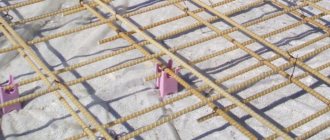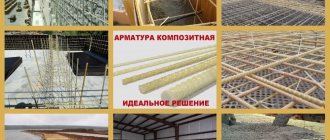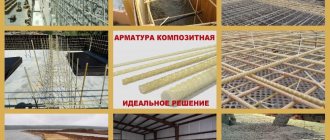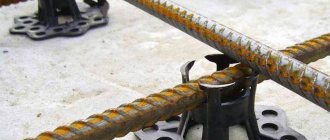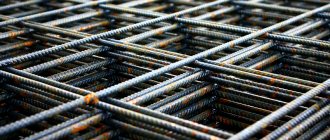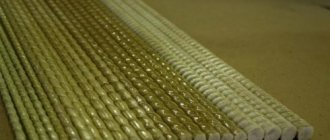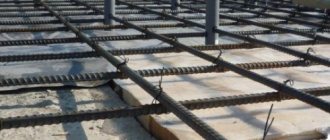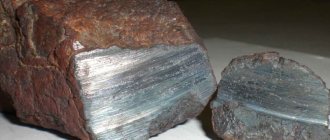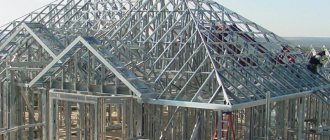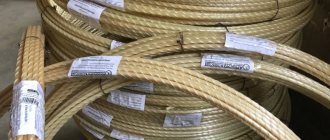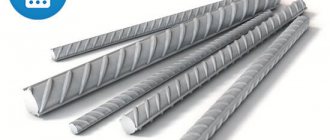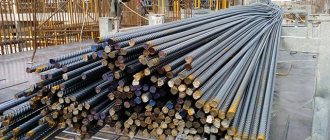Relatively recently, metal reinforcement was not just the most common - it was the only material of its kind. It is not surprising that all concrete reinforcement was carried out with its help. But today the market is saturated with numerous analogues, most of which are superior to metal rods in a number of parameters. One of them is composite reinforcement, also known as plastic. Let's take a closer look at what it is.
Foundation made of fiberglass reinforcement: reinforcement rules
Fiberglass reinforcement, which is used to strengthen the foundation, belongs to the category of new building materials that are superior to previous ones in many characteristics. Most consumers do not yet know whether it can be used to reinforce aerated concrete walls or to strengthen the foundation. This article will provide answers to these and many other questions.
The use of fiberglass reinforcement in the foundation.
The use of fiberglass reinforcement in slab foundations.
Standard sizes and parameters
The diameter of the produced spa varies in the range of 4 – 18 mm. Products are produced in the form of measuring rods or in coils.
The total length of the reinforcement in the coil depends on the technological equipment used in its manufacture. Spas with a diameter of 12 mm or more are offered to the consumer exclusively in the form of rods.
The main parameters affecting the scope of application include the weight of one meter and the diameter of the composite rod.
The winding pitch can be considered an additional characteristic, but today almost all manufacturers produce reinforcement with a pitch of 15 mm.
What is fiberglass reinforcement?
Reinforcement, for the production of which fiberglass materials are used, was developed quite a long time ago, back in the 1960s. However, due to its high cost, it was used only in harsh climates, where conventional steel reinforcement structures, susceptible to corrosion, could not last long. The reinforcement, which was made from fiberglass materials, was used mainly to strengthen bridge supports and other equally important structures operated in fairly harsh climatic conditions.
Over time, the development of the chemical industry has contributed to a significant reduction in the cost of fiberglass reinforcement. This made it an affordable material that performs well in building structures for various purposes. The active use of this type of reinforcement led to the fact that in 2012, experts developed and approved GOST 31938-2012, the provisions of which stipulate not only the requirements for the production of this material, but also its testing methods.
GOST 31938-2012 Composite polymer reinforcement for reinforcing concrete structures. General technical conditions
Fiberglass reinforcement.
The surface of fiberglass reinforcement can be corrugated, smooth or powdered.
In accordance with the state standard, fiberglass reinforcement is produced in the diameter range of 4–32 mm. However, the most common diameters for products of this type are 6.8 and 10 mm. Such fiberglass reinforcement products are supplied to the customer in coils.
This standard, in addition to the requirements for the diameter and other geometric parameters of fiberglass reinforcement, specifies what the condition of its outer surface should be. So, on the surface of the reinforcement there should be no chips, delaminations, as well as dents and other defects.
What to look for when choosing
When the choice fell on the use of fiberglass reinforcement when performing construction and installation work, then when purchasing it you should pay attention to such indicators as:
- Diameter - must correspond to the declared values.
- The color of the fittings must be uniform and with shades no darker than those in the declared characteristics.
- The quality of winding of the outer layer.
- Products must have appropriate quality certificates and test reports.
Important! The presence of SPA color in darker shades than those declared by the manufacturer indicates that the manufacturing temperature conditions were violated during the production process. Reinforcement of this color is burnt and its technical characteristics cannot correspond to the declared ones.
The flexibility of SPA allows it to be used in the construction of structures of complex geometric shapes without cutting.
When choosing a SPA, it is best to initially find out the reputation of the company producing this material, for which you should read reviews on the Internet and other sources of information.
Expert's point of view
Dmitry Kholodok
Technical director of repair and construction
Ask a Question
“When winding the outer layer of reinforcement, pinching of the inner rod of the product should not be allowed, because otherwise, the strength characteristics of the spa will be compromised.”
Related article:
DIY strip foundation: step-by-step instructions. In the article we will look at the pros and cons of this foundation, the nuances of its correct pouring, as well as which brand of concrete is best to choose in order to get a high-quality structure.
Main characteristics and main disadvantage.
Based on the type of continuous reinforcing filler used, composite products are divided into the following categories:
- ASK – glass composite;
- AUK – carbon composite;
- ACC – combined;
- other.
If it is necessary to use fiberglass reinforcement to strengthen the foundation of a house, the following characteristics should be taken into account. Upper temperature limit during operation.
The lower limit of this parameter for glass-composite reinforcement products starts at 60 degrees Celsius.
Tensile strength.
This parameter is characterized by the ratio of the applied force to the cross-sectional area of the product. For ASK it should be 800 MPa or more, for AUK - at least 1400 MPa.
Tensile modulus
According to this indicator, fittings of the AUK category are more than 2.5 times superior to ASK.
Compressive strength.
This indicator for fiberglass reinforcement of all categories must exceed 300 MPa.
Shear strength
For ASK this parameter should be more than 150 MPa, for AUK - 350 MPa or more.
Fiberglass reinforcement properties application.
Advantages of fiberglass reinforcement.
Reinforcement made of polymer materials has a significant drawback: it has very low fracture strength. Due to this drawback, the scope of use of this fittings is limited. Manufacturers of such products must indicate the scope of their application, and if the consumer goes beyond the specified scope, he does so at his own peril and risk.
The use of reinforcement of this type is justified only in cases where increased demands are placed on the thermal conductivity, corrosion resistance and dielectric characteristics of reinforcing structures.
Disadvantages of polymer reinforcement
- Heat resistance is lower than that of steel . The material can withstand heating up to +200°C, basalt composite – up to +300°C. For steel this figure is +500 °C. Therefore, steel reinforcement is used to lay the foundations of high-temperature facilities (home ovens, bathhouses, smelting furnaces).
- Low ductility . Changing the shape of reinforcement without heating is not easy. Trying to bend a polymer rod will cause it to break. He's fragile. It cannot be bent at an angle “L” or “P”, like iron. This complicates the installation of the foundation frame.
- The elastic modulus is 4 times lower than that of steel . It bends easily. This drawback is taken into account when reinforcing floors. To build a floor of the required strength, it is important to make the correct calculations.
- Formation of fine particles and dust . Occurs when cutting polymer reinforcement. This work is carried out in protective clothing and glasses to avoid damaging the skin, eyes, and mucous membranes with fine dust, glass particles, and fibers.
- Availability of low-grade goods . The production of polymer reinforcement requires strict quality control at all stages: from the preparation of raw materials to transportation of the finished product. Not all manufacturers produce high-quality products. The buyer suffers from this. Using low-quality reinforcement, he pours an unreliable foundation, which creates a bad reputation for this building material.
Comparison with metal fittings.
Fiberglass fittings, when compared with metal ones, have the following advantages.
- Reinforcement products of this type are characterized by high corrosion resistance: they are not afraid of both acidic and alkaline environments.
- Fiberglass reinforcement is made from polymer materials, so it is distinguished from metal products by very low thermal conductivity. Thanks to this, when used to reinforce foundations and other building structures, there are no cold bridges, which is especially important for our climatic conditions.
- This fittings, made of dielectric, do not conduct electric current and also do not generate radio interference.
- The specific gravity of fiberglass reinforcement is 8–10 times less when compared with its metal counterparts.
- The cost of metal and fiberglass products for reinforcing building structures is almost the same, but using fiberglass reinforcement is much more convenient.
- In terms of tensile strength, which for similar steel products is 400 MPa, fiberglass reinforcement is two to three times superior to metal rods.
- Fiberglass reinforcement is produced in rods 100–150 meters long, which makes it possible to install reinforcing structures practically without seams. Experts know that the joints of metal reinforcement are the weakest points of reinforcing frames. When strengthening foundations and other building structures using fiberglass products, there are no such weak points in the reinforcing frame.
- The advantage of using fiberglass reinforcement is that the consumer can purchase exactly as much product as he needs without paying for unexpected waste.
- To install and lay the reinforcement frame, which is made of fiberglass elements, there is no need to use a welding machine or other specialized equipment.
- Fiberglass reinforcement is much more convenient to transport, since it can be supplied to the customer both in rods and in coils, which can easily fit even into the trunk of a car.
- When foundations and other concrete structures are reinforced with fiberglass, cracks do not occur in the latter, which is explained by the fact that fiberglass and concrete have similar thermal expansion coefficients.
Materials for production
Today, the composite reinforcement market is represented by three types:
- fiberglass
; - basalt plastic
; - carbon fiber
.
Fiberglass reinforcement
The first type of reinforcement is made of fiberglass. This technology appeared in the USSR about 50 years ago. Then printed wiring in radio electronics began to gain momentum, and textolite began to be used as a material for boards, when the base was fabric and the fastening composition was artificial resin. Later, fiberglass was used instead of ordinary fabric, and this expanded the use of fiberglass.
It has found its place in aircraft manufacturing, furniture and household goods, and sometimes even in the military industry. Gradually, it began to be used in construction, and fiberglass reinforcement became an excellent option for foundation frames operating in aggressive conditions, for example, in water.
The materials for fiberglass are glass and epoxy resin.
This material does not contain fiberglass, but basalt. Its manufacturing technology is simpler than glass, because glass production requires several types of raw materials, while basalt plastic
- only basalt.
Compared to the previous composite, basalt plastic has a higher elastic modulus and tensile strength, has lower thermal conductivity, but is slightly heavier.
Carbon fiber reinforced plastic
It is made from carbon fiber and the same resins, but this material is expensive. This is due to the production technology of carbon fiber - the basis of such materials. Technological process
requires strict adherence to temperature and processing time parameters, since organic fibers serve as the raw material.
Carbon fiber plastics are actively used in the automotive industry, the production of sporting goods, aircraft and shipbuilding, and science.
Carbon fiber reinforcement is stronger than fiberglass and has a higher modulus of elasticity, but it is not without its drawbacks. Thus, the fragility of this material is great, which does not allow its use in long, stressed structures such as floor slabs.
Areas of application.
Reinforcement made from fiberglass is used in both residential and industrial construction. The popularity of this material, used for reinforcing foundations and other concrete structures, has recently been gaining momentum.
Considering the above advantages of fiberglass reinforcement, we can draw conclusions about where it is better to use this innovative material, and where you can resort to the most traditional and time-tested options. For example, very common areas of use of reinforcement made from fiberglass are bank protection, as well as reinforcement of road surfaces in areas where it is exposed to aggressive environmental factors.
Fiberglass reinforcement area of application.
Fiberglass reinforcement is often used in the construction of bridges and overpasses.
In cottage construction, reinforcement made of fiberglass is also widely used. In particular, such products are used for reinforcement:
- concrete structures acting as fencing (it should be borne in mind that fiberglass products cannot be used to reinforce load-bearing structures and floors);
- strip and other types of foundations;
- masonry made from aerated concrete and foam concrete blocks.
The use of fiberglass reinforcement in the foundation.
Composite reinforcement is also used in the construction of walls using permanent formwork technology.
Many experts agree that when using fiberglass reinforcement for laying gas and foam concrete blocks, it is better to reinforce the corners using steel products. With such combined reinforcement, building structures will have higher strength, stability and reliability.
Range and price of composite reinforcement
The most in demand at construction sites is fiberglass composite reinforcement. We have summarized its range and average prices in one table.
You can get information about how much plastic fittings of different diameters weigh from the table below.
The material is sold in coils of 200, 100 and 50 meters and in the form of rods of any length.
Strengthening foundation structures.
When used to reinforce strip and other types of fiberglass foundations, rods with a diameter of 8 mm are used, which is equivalent to the use of 12 mm steel reinforcement.
Fiberglass reinforcement properties application.
Calculations for replacing steel reinforcement with fiberglass.
It is not difficult to carry out the procedure for such reinforcement with your own hands, if you adhere to the following algorithm.
- When installing the formwork, it is recommended to wrap its elements with parchment, which will allow them to be reused.
- On the inside of the formwork elements, using a horizontal level, mark the line up to which the concrete solution will be poured. This procedure will allow the concrete solution to be more evenly distributed throughout the entire internal volume of the future strip or any other foundation.
- The reinforcement elements with which you will strengthen your foundation must be covered with a layer of mortar at least 5 cm thick. In order to maintain this distance, you can use ordinary bricks that are laid on the bottom of the future foundation.
- Two rows of reinforcement are placed on the bricks laid at the bottom of the future foundation. In this case, it is desirable that solid rods be used, without joints. By measuring the length of the sides of the foundation being poured, you can easily determine how long the rod you will need to unwind and cut from the overall coil.
- After laying the longitudinal reinforcement bars, it is necessary to attach transverse jumpers to them, which are fixed with plastic clamps.
- Then you need to make the upper level of the reinforcement cage, which should be identical to the lower one. Both levels of such a frame, the cell dimensions of which should be approximately 150 mm, are connected using vertical jumpers.
- After making the reinforcement frame, they begin pouring the concrete solution. It is up to you to decide what concrete mixture will be used for this, but preference is most often given to the M400 brand solution.
Fiberglass reinforcement, application features.
Reinforcement of the foundation belt with fiberglass reinforcement.
Fiberglass reinforcement used in construction.
To quickly and continuously pour the foundation, it is better to use the services of a mixer
It is not difficult to calculate how much mortar you will need to fill the foundation: to do this, you need to calculate the perimeter of the future foundation, and then multiply the result by its width and depth. When pouring concrete mortar with your own hands, it is important not to forget that it must be compacted periodically so that air bubbles do not form in the foundation mass.
It will take 2-3 weeks for the poured concrete solution to completely harden. During this period, the poured foundation must be covered with a film from rain, and if the weather is hot outside, its surface must be periodically moistened with water.
Reinforcement made from fiberglass is a relatively new material on the domestic construction market that has not yet stood the test of time. Therefore, when using such material to reinforce concrete structures, you must understand the extent of responsibility for your choice.
Technology of foundation reinforcement with composite materials
The low weight of plastic reinforcement for the foundation simplifies the process of assembling a reinforcement frame of any design. At the same time, due to the increased strength of the material, the cross-sectional diameter is taken one number less than for metal analogues.
The technological process of installing concrete monolithic structures using polymer rods consists of the following stages:
- installation of formwork and marking the level of pouring concrete mixture;
- assembly and installation of the reinforcing frame;
- pouring concrete into formwork;
- removal of formwork panels.
Work on the installation of reinforced monolithic structures must be carried out in accordance with the adopted design decisions. The deck configuration must fully correspond to the size and shape of the foundation. As formwork material, you can use standard factory-made panels, boards, moisture-resistant plywood or chipboard. For permanent formwork, expanded polystyrene sheets are most often used.
After assembling and securing the formwork panels, on their inside, using a water level, mark the upper limit of pouring the concrete mixture. This will reduce the time it takes to complete the job and help distribute the concrete more evenly.
Spatial reinforcing frame for strip foundation
The foundation reinforcement scheme, laying and rod diameter are always indicated in the project. The use of composite reinforcement, especially those based on carbon fiber, makes it possible to reduce the diameter of the rods by one size. The laying of the material must exactly correspond to the calculated data. The frame is assembled on a level area.
The work begins with cutting the workpieces. To do this, pieces of the required length are unwound from the coil and placed on stands at a height of 35-50 mm above the support pad or ground. After this, the transverse jumpers are laid according to the drawing, and at the intersections they are tied with wire or ties. In this way, the bottom row of the spatial reinforcement frame will be assembled.
At the next stage, it is necessary to assemble a lattice completely similar to the first one, lay it on top and then cut the vertical posts to the designed length. The first post is tied at the corner of the flat gratings, the second at the adjacent intersection, as a result, a spatial structure is gradually formed. If there are more horizontal rows, then the second grid is fixed at the required height, and then the next one is fixed. The vertical post in this case is one whole segment.
It is necessary to pour a sand-crushed stone cushion at the bottom of the trench and compact it well. After this, it is recommended to cover the sand layer with geotextile or waterproofing material. This will prevent moisture from entering the concrete and the germination of weeds.
Horizontal reinforcement of slab foundations
When pouring slab-type foundations, horizontal reinforcement technology is used. Its main feature is the absence of turning and adjacent sections. Usually these are two grids located one above the other from long straight rods and vertical posts.
All work is carried out on site. First, according to the design drawing, the lower mesh is knitted, and the upper mesh is laid on top of it. After this, vertical posts are installed, as described for strip structures. The lower mesh must be installed on stands.
Pouring concrete onto a plastic reinforcement frame
Technologically, pouring a concrete mixture is no different from work using steel reinforcement
However, given the lower strength of the material under lateral radial impact, compaction with a vibrator should be done carefully so as not to damage the integrity of the plastic rods
The construction industry is constantly evolving. New materials that meet high requirements are appearing on the market. Residential and industrial buildings are built in a short time. During their construction, various modern materials and innovative technologies are used. Recently, fiberglass reinforcement was introduced to developers, which began to compete with time-tested steel rods.
Fiberglass reinforcement for foundations: technology features.
Fiberglass reinforcement.
Today, the use of the latest technologies in the construction of houses and industrial buildings is very common. The use of old technologies is now practically not implemented anywhere. The constant demand for newer and more advanced technologies also left its mark on the laying of the house frame, where new fiberglass reinforcement was needed for the foundation.
All kinds of foundations allow you to make it as strong and durable as possible. The operation of foundation reinforcement with fiberglass reinforcement has shown positive results and reviews from both builders and buyers. Such composite products have a number of advantages over others:
- Using the composition when completely immersed in water
- Completely moisture resistant
- Withstands extremes and very high temperatures
- Not afraid of exposure to chemicals
Fiberglass reinforcement.
Construction of a foundation using reinforcement.
The foundation is the main and, perhaps, the most important part of any structure. Improper installation can lead to the fragility of the foundation and complete deformation of the house. The use of reinforcement is often necessary to maintain and increase the strength of the foundation itself. Such fiberglass reinforcement for the foundation is fastened together into one frame, which will then be filled with concrete mixture to obtain a single monolithic slab.
To get a high-quality frame, you should think about purchasing a special tool that will allow you to quickly deal with the bending of the reinforcement and its rods without loss of quality.
At the moment, there are various filling options:
For the construction of residential buildings, a strip or monolithic variety is most often used. To create this kind of foundation, it is necessary to use reinforcement to make the frame.
The variety of this kind of construction assortment, from the usual classics to the innovations of technological progress, simply captivates the eye and confuses almost any buyer. Many people don’t even know half of these materials, although they are more convenient and practical than the classic old building materials.
One of the new introductions was the appearance of fiberglass reinforcement on the market. Not many people know what fiberglass reinforcement is and do not use it to the extent it deserves. It consists of rods with a diameter of 4-20 mm and any construction length as required.
It is often used in the construction of civil, road and concrete structures with prestressed and stressed reinforcement of the base, instead of conventional classical reinforcement. Such reinforcement is an almost eternal material that is not afraid of any impacts or sudden temperature changes. It can withstand enormous loads and is very maneuverable, which allows it to be used in the heaviest buildings. Selecting the required length significantly facilitates installation and increases the strength of the structure, in comparison with the connecting characteristics of other fittings that are mounted by fastening to each other.
The advantages include:
- Greater material strength
- Not subject to corrosion
- Acid-resistant fittings
- Is diamagnetic with dielectric properties
- Can be used in the construction of a hospital, airport, radar station
- Radiotransparent
- Does not lose its functions due to temperature changes
- More than 5 times lighter than conventional reinforcement
The use of fiberglass reinforcement in the foundation.
Ordinary metal fittings.
- Possibility of purchasing any length
- Durability
- Significant reduction in costs for unloading/loading material
Ribbed and smooth rods
The ribbed profile of the products is necessary to improve adhesion to the concrete mixture. Sometimes, for the same purpose, the surface of the reinforcement is sprinkled with sand during the hardening process.
Fiberglass rods with a smooth surface cannot have proper adhesion to concrete, which is why they are less in demand as reinforcement for concrete work.
But the price of smooth rods is much lower, so it makes sense to use them as auxiliary products with minimal load when assembling a frame for reinforcement.
Construction technology.
To build a strip foundation, precise calculations and a specific action plan are used. To begin with, dig a trench 30-80 cm in length. Its dimensions are calculated from the necessary measurement data, weight and area of the future structure.
Then, depending on the type of land, conditions and overall mass, the filling depth is calculated. The usual standard depth ranges from 60-80 cm, but with individual calculations, the depth of the strip foundation can be completely different.
A kind of cushion layer is created with the addition of gravel, which will improve installation. It needs to be watered very heavily. Fiberglass reinforcement is created for a strip foundation with an area of 10 mm. Its installation takes place on bricks or other possible supports with the expectation that 5-10 cm remains from the bottom.
The initial rods are mounted with a registration and program distance from the walls of the pit of 10 cm, then the vertical and transverse posts are tightly secured at an equal interval of 40 cm. The first two upper rods of reinforcement are fixed on them and tied together with transverse rods.
Fiberglass reinforcement.
Types of fiberglass reinforcement.
The form (formwork) of the foundation is made. To do this, take an edged board 25 mm wide and knock together rectangles of the required size (taking into account the measurements of the foundation), which should be about 30 cm above the ground level. After this, a box is assembled from the prepared rectangles and installed in place of the foundation, Place spacer bars and sprinkle the soil.
The finished form is filled with concrete. If support pillars were used, they must be mounted and precisely aligned with the concrete pouring level. This is all done based on calculations and data obtained.
How is mating carried out?
The key to creating a reliable reinforcing frame is the competent connection of the elements that make it up. The methodology for carrying out the work depends on the specifics of the object and the technical specifications of the construction project. There are several connection methods.
- Clips. The rods are fixed using a special bar with presses. This method is the simplest, fastest and most convenient. The components are fastened at an angle of 90°. The size of the clips must correspond to the diameter of the reinforcement used. This connection ensures strength and rigidity of the structure.
- Plastic clamps. This is the second easiest method of connecting spas. The clamps are tightened at the intersection of the rods. For greater rigidity, two clamps are cross-connected at once. Using pliers, remove the excess part of the fastener. It is not recommended to leave protruding ends as they can create voids. Moisture entering them will negatively affect the strength and durability of the structure.
- Metal wire. In this case, a simple or semi-automatic hook is used. The method is suitable for bars of various diameters.
To connect the SPA, there are special fasteners that are secured with latches. There are special automatic tying guns that fasten rods to staples or wire.
Knitting SPA when reinforcing screeds
The design of concrete floors, thick screeds and slab foundations is carried out using plastic racks. Each of them is an independent reinforcing element. The rods are secured at right angles with crimp latches along the edges of the post. For such a connection, it is not necessary to cut large pieces of reinforcement and knit between horizontal layers.
For thin screeds, it is allowed to use clips for composite reinforcement having a C-shape. With their help, it is easy to obtain the required gap between the base and the reinforcing mesh.
Knitting fiberglass reinforcement for strip foundations
If there are intersections, corners, or lateral junctions, the frame lines are connected using U-shaped parts. They allow you to connect external reinforcement to a perpendicular mesh. The corners are formed by attaching L-shaped rods to the main frame with two wire ties. The resulting overlap must be at least 300 mm. Finished reinforcing mesh is connected by straight sections. All intersections are knitted inside the formwork at the installation site. The distance from its borders must be at least 25 mm.
It is not recommended to heat reinforcing bars to create a bend yourself. This can lead to loss of strength characteristics of the material. To avoid problems, ready-made rods of the required shape are ordered.
Strapping is an important process to obtain a strong frame structure. Compliance with technology serves as a guarantee of quality.
Selection of materials.
In principle, different materials can be used for the future structure. If the foundation has to be laid on the site of a groundwater area, then it is necessary to think about possible drainage channels and lay special waterproofing. To reduce the pressure on the brick wall and its base, the width of the foundation should be made wider than the width of the walls.
This is explained by the possible installation on poles and the phenomenon of a kind of solid sailboat under such conditions, and if the foundation is not too deep, the supports may not withstand the load and pull out.
The reinforcement process is carried out using an equipped special hook and steel wire. A reinforced foundation can withstand heavy loads, and a fence installed on it can last for many years.
Necessary materials and tools for work
Fiberglass reinforcement cannot be welded, it can only be knitted, so the main tool used in installation will be a special crochet hook attached to a wooden or plastic handle. The tool can have different designs and sizes, so the price varies significantly. The most inexpensive crochet hook costs 150-200 rubles, and in order to use it freely, you just need to get a little practice in your hand.
For a large amount of work, you can purchase a cordless knitting gun charged with a wire spool - however, the tool is too expensive for one-time use. Installers often use a screwdriver for this purpose with a homemade hook made from a large nail installed on it. The most convenient way to hold the wire and make twists is with pliers. In general, one connection takes no more than 4-5 seconds.
To assemble a frame from fiberglass reinforcement, you will need annealed wire with a diameter of 1.2 mm or plastic clamps. Plastic fasteners are also needed, due to which a concrete protective layer is created around the “skeleton” of the foundation. Due to its shape, the lower stand is called a stool - the rod is simply placed on its horizontal part. The side lock has the shape of an asterisk, the rays of which provide the necessary indentation. In the center it has a hole into which the reinforcement rod is threaded.
Bottom row of fittings on stands
Stages of foundation construction.
Fiberglass reinforcement.
Preparation of fiberglass reinforcement for foundation construction.
To install a strip foundation yourself, you need:
- accurate calculation of land characteristics
- climatic, tectonic and hydraulic data at the site of the future fence
- digging a trench
- calculation of fiberglass reinforcement for the foundation
- box installation
- laying the formwork
- drainage and hydraulic channels (if necessary)
- waterproofing (if necessary)
- pouring strip foundation with concrete
- drying out of the foundation
Any beginning of foundation installation begins with studying the area of the future installation: its characteristic above-ground and underground data, soil type, air humidity. The time of year for pouring also plays a significant role.
It is preferable to perform such operations in the warm season, when periods of frost and rain have passed. When laying a foundation in the fall or winter, you can end up with a poor, cracked foundation and poor support for the building as a result. Strict adherence to the calculations given for digging a trench will help you avoid mistakes and get a good result. When using a plywood sheet for formwork, it is possible to paint it, which will be clearly visible for pouring concrete.
To sum it up.
As can be seen from the list, making a strip foundation on fiberglass reinforcement is not difficult and does not require special knowledge. Having understood what fiberglass reinforcement is, everyone can significantly reduce their time and money for installing a box and at the same time benefit from the quality and strength of the material.
The only condition is that the construction be carried out in stages. Each stage should begin after the previous one is completely completed. When installing a foundation, calculations of depth and thickness are very important, and software calculations on a computer help with this. By calculating future data in this way, you can significantly reduce the time spent on unnecessary measurements and unnecessary consumption of materials.
The choice of materials for installation and manufacturing also plays a significant role. It is worth giving preference to high-quality, certified material and components when receiving it. Using good material and accurately following the action plan is the key to obtaining a reliable foundation in the future.
It is worth noting that the entire building and its future condition will directly depend on the correctness of the foundation, since it is the main support for the future building and its installation should be taken as seriously as possible.
Analysis and comparison of the main parameters of two types of reinforcing materials
You can get a complete and reasoned answer to the question of which fittings are better by carefully comparing the main parameters of plastic and metal fittings.
| Properties of materials | Steel reinforcement | Fiberglass composite |
| Elasticity and plasticity | The metal has a fairly high level of these material properties | The fiberglass barrel has a high level of elasticity |
| Tensile strength | Steel reinforcement is inferior to plastic reinforcement in this property. This value for this material is 390 mPa. | Fiberglass threads have a great advantage. The strength of the material is 1300 mPa. |
| Coefficient of thermal conductivity | In this matter, metal is significantly inferior to its opponent. This coefficient is 46 W/(m*K). | This value is much less than that of steel and is equal to 0.35 W/(m*K). |
| Material Density | For this characteristic, steel rods are preferable. Their density is 7800 kg/m3. | Here, fiberglass is significantly inferior to steel. Its density is 1900 kg/m3. |
Due to the resistance of plastic to corrosion and chemicals, it is preferable to steel. This material is also better in terms of electrical safety and not obstructing radio waves into the room. In general, no specialist can decide which material is preferable.
Only by completing other elements of the building and comparing it with the calculation of the structure using steel reinforcement can you get a reasoned answer. And only after this we reinforce the building parts and concrete products calmly and with confidence in the chosen material.
Composite reinforcement for foundations: advantages, disadvantages, application.
Fiberglass reinforcement.
Until recently, reinforcement made of metal rods was considered not only the most reliable, but also the only acceptable option for creating a strong “skeleton” of the foundations of buildings for any purpose. The material in question did not appear yesterday (there are references to the experience of its use since the late 70s). But composite reinforcement did not gain popularity, so they forgot about it in our country for a while. But in foreign countries it was actively used. Therefore, we can talk about the successful use of composite rods for reinforcing concrete structures. And judging the strength and stability of such structures is not unfounded, but based on facts.
A few myths from unscrupulous manufacturers and sellers.
Fiberglass reinforcement, although not a new material (as it turned out), is unfamiliar to most consumers. The fact that advertising positions it as an innovation is nothing to worry about. It’s worse when, taking advantage of the ignorance of potential customers, the manufacturer tries in every possible way to increase the selling price of the product, pointing out the supposedly unique properties of its composite reinforcement.
Composite reinforcement photo.
Fiberglass reinforcement area of application.
While an ordinary private developer is collecting information about it bit by bit, getting acquainted with the properties and features of its application, and large construction companies are calculating the income and expenditure side of the budget when switching to a composite instead of metal, rumors are growing and multiplying. And they require a reasoned and honest answer.
One of the most common myths can be debunked right now.
- Externally, this building material is light rods with various shades of yellow (if they are made of fiberglass) or pronounced black (provided that basalt was used). However, an attempt to make the product more attractive in appearance, namely the addition of coloring pigments of various shades, made it possible to introduce colored fittings to the market. And a myth immediately appeared: these additives do not simply color the rods, but are special components that improve the characteristics of the material . Serious manufacturers give a clear answer: color does not affect the quality of composite reinforcement.
Fiberglass reinforcement.
- In addition to improving the presentation, there is also a very noble impulse behind such experiments with color: to highlight rods of different diameters.
Reading the regulatory documentation for building materials will help you not to fall for the tricks of dishonest sellers.
Application of composite reinforcement.
Composite reinforcement is gradually gaining space from its metal counterpart in the area of laying the foundations of low-rise buildings. Glass, carbon, basalt or armide fibers are used as the basis for its production. They are bonded to each other by adding polymers.
Fiberglass reinforcement can also be produced in the form of smooth rods, but when it is supplemented with a spiral winding of glass thread, more reliable adhesion to the poured solution is ensured. So it’s better to give preference to the second option.
Experts cite a number of advantages of composite reinforcement:
- ease of transportation and use due to low weight. In addition, no welding is used during installation;
- resistance to various aggressive environments;
- corrosion resistance;
- tensile strength.
Fiberglass reinforcement.
To create a foundation, composite reinforcement of a certain diameter is required. The section is calculated individually for each object. It depends on the number of floors, the complexity of the project and a number of other reasons. It is important that, while not being inferior in strength to metal rods of the same diameter, composite reinforcement will be lighter in weight.
Composite reinforcement for foundations.
- When laying a foundation, composite rods are used in the same way as steel rods. A frame is assembled from them according to the recommendations for a certain type of base with the required pitch, and at the intersection points the reinforcement elements are fastened with ties or binding wire.
- Developers and manufacturers do not give recommendations prohibiting the use of composite reinforcement for the construction of any type of foundation. That is, if the developer wishes, any foundations for a low-rise building can be made using fiberglass reinforcement.
- But you can accurately determine in which foundations composite rods have proven themselves to be the best. We are talking about strip or column methods for buildings no more than three floors high. For those who want to build: a private house, a cottage, a bathhouse, a garage, a solid building for economic purposes.
Fiberglass reinforcement for use in the country.
- The service life of elements of non-metallic origin is quite long - 80 years according to minimum calculations. Their cost may be only slightly different from the price of conventional steel rods, but it is quite possible to save on transportation. The fittings, packed in a bay, can easily fit into the trunk of a passenger car.
- Construction conditions and technologies vary. Where reinforced concrete structures will be operated in an environment that is aggressive to metal, it makes sense to use non-metallic reinforcement.
- Composite reinforcement, selected with equal strength to a reinforced concrete frame, will create a reliable foundation. And it will last much longer (due to resistance to the destructive effects of the environment and “complete indifference” to the corrosion process).
For massive concrete buildings, the following types of fiberglass reinforcement are used:
- External . Justified in cases where concrete structures are exposed to destructive effects in an unfavorable environment. The characteristics of composite reinforcement, produced specifically for these purposes, make it possible to create a protective barrier around the structure. It is impenetrable to both air and water. This method is called continuous. Sometimes, when using it, they do the opposite. First, the frame is made, and then it is filled with concrete.
- The discrete method means that composite meshes or strips of reinforcement strengthen the base from the outside.
Fiberglass reinforcement, application features.
- Discrete reinforcement assumes that composite meshes, individual rods, or even volumetric frames created from many elements will be placed inside the structure.
- The dispersed method is somewhat simpler - crushed glass fibers are added to the total mass for pouring. The resulting material is called glass fiber reinforced concrete.
- A joint . The combined method got its name not only because of the simultaneous use of two types of reinforcement, but also because it allows a combination of fiberglass and metal rods. It is used when significant weight loads are expected on the foundation.
Diameter of composite reinforcement.
If you have never encountered such a problem before, the following information may be useful.
Fiberglass reinforcement.
- Due to its design features, metal reinforcement has several indicators that characterize the diameter: the external one is measured along the ribs protruding along the profile;
- the inner one belongs to the rod itself;
- nominal, which is expressed as an integer, is the profile number.
Fiberglass reinforcement.
- In order to carry out calculation work and when purchasing material, you need to know the nominal diameter. In the conditions available to a simple home craftsman, this indicator cannot be obtained. For those for whom solving such a problem is vital, there is one trick.
- The nominal diameter is essentially the average number between the outer and inner gauge sizes. Further, the sparser the ribs are located on the rod, the more the internal diameter approaches the nominal value.
That is, you can catch an unscrupulous seller trying to pass off the outer diameter numbers as its nominal size like this:
- you need to measure the outer diameter;
- take measurements of the internal diameter;
- compare the number given by the seller with both indicators.
If the outer diameter coincides with the nominal number according to the seller, you should buy the fittings elsewhere.
Weight of composite reinforcement.
Fiberglass reinforcement properties application.
Methods for connecting composite reinforcement.
Among the advantages of composite reinforcement listed above, one of the points indicated that its use does not involve welding. The rods are assembled into a frame by tying them together.
Plastic ties are used less frequently, but builders value tying wire more. This material is more traditional and has not yet been eradicated by new trends. It is carried out in the following ways:
- using an automatic pistol;
- using a crochet hook for construction (simple configuration);
- using a screw (motorized) construction crochet hook.
The popularity of the last two options is explained by the availability of the tool. It’s rare that anyone can afford to purchase an expensive pistol just to build one foundation. Some large companies, however, practice renting out expensive but very simplified equipment. And if such an opportunity arises, then it’s worth taking advantage of it.
Among the arguments for automating the knitting process are the following:
- It is quite obvious that mechanized labor is more effective and productive;
- Having such an “assistant” you can avoid overpaying hired workers. With its use, one person can handle the strapping on their own;
- the gun makes equally smooth and strong knots on the entire frame;
- the tool is functional at any temperature;
- A powerful battery allows you to work uninterrupted all day.
The use of fiberglass reinforcement in the foundation.
Particularly advanced models of this tool are equipped with a device that allows you to tie rods without bending close to them.
Foundation with composite reinforcement and construction in earthquake-prone areas.
- Another proof of the excellent strength characteristics of composite reinforcement can be seen in its use in other areas of construction that require withstanding significant loads: walls and floors of buildings, road surfaces, coastal structures, bridges.
- But it’s rare to find mention that composite reinforcement can withstand impressive earthquakes. About five years ago, the Kucherenko Research Institute of Building Structures studied the behavior of this material under large dynamic loads. Reinforcement with a diameter of 8 mm was tested by an “earthquake” from 5 to 10 points. With its help, prototypes of panels were reinforced, which were subjected to appropriate loads and placed on vibration platforms. The material remained intact up to magnitude nine seismic activity!
Composite reinforcement video.
Fiberglass reinforcement is a durable and easy-to-use material. Today it is a worthy replacement for metal rods, and its use for pouring foundations for low-rise construction can be considered not only justified, but also an extremely desirable action on the part of the developer. This is why there are so many positive reviews about composite reinforcement among private developers.
Recommendation: This is just a review article, from it you will learn about the use of fiberglass reinforcement in the foundation. You need to carefully study your specific situation, weigh all the pros and cons, and also calculate the difference between the cost of metal and fiberglass reinforcement. Then put on one side of the scale the cost and risks when using metal reinforcement, and on the other side of the scale the cost and risks when using fiberglass reinforcement. May you make the right choice for your situation.
Composite reinforcement. Is glass stronger than metal?
In the history of mankind, technologies for the production of building materials have never stood still, moving forward at different rates, responding to the needs of a growing population. The priority has always been the speed of production and installation of products, durability, as well as reducing their cost by using cheaper resources. The invention and use of composite reinforcement was no exception. When in the distant sixties of the twentieth century the first samples of this unique building material arrived at construction sites, few believed that a replacement had come for the then seemingly unshakable traditional steel reinforcement. But as time has shown, their doubts were not confirmed. Composite reinforcement has occupied a worthy niche and is widely used today throughout the world. The main component of this reinforcement is glass roving, which is a white strand consisting of untwisted fiberglass strands. These threads are interconnected with a polymer based on epoxy resin.
For ease of delivery, the reinforcement is rolled into a coil, the length of which may depend on the wishes of the customer. Composite reinforcement is resistant to deformation and is quite flexible, which allows it to straighten out like a spring when unwinding the coil and take its original form in a short time. Composite reinforcement has an undoubted advantage over its metal counterpart. Composite reinforcement is not subject to corrosion, electrical conductivity and metal fatigue; its weight is approximately 5 times less, which, given its compact size, does not create unnecessary hassle during transportation and loading and unloading operations. In tensile tests, it outperformed many classes of steel reinforcement. Among other advantages of this fittings, one should highlight its acid resistance and protection from the effects of sea water, the almost complete absence of thermal conductivity, and radio transparency. Composite reinforcement does not lose its properties at ultra-low or ultra-high temperatures (their range ranges from -70 to +90 degrees Celsius), as well as under the influence of electromagnetic fields. Structures built with its help last an average of 70 years, which is twice as long as when using steel reinforcement.
Composite reinforcement is used everywhere in the construction of various structures. Due to its wear-resistant qualities and protection from caustic liquids, it is preferred in the construction of offshore and onshore structures, and in some components of chemical infrastructure, in order to reduce the likelihood of leakage of harmful substances. Over the years, it has increasingly found its use in restoration and repair work, in road and railway construction, in the construction of bridges, houses, sewerage and water supply units. Over time, this list only lengthens, as composite reinforcement finds more and more new areas of application.
Nowadays, the production technology of composite reinforcement is so high that it has made it possible not only to significantly reduce the cost of its production, but also to surpass the cheapness of its metal counterpart. Therefore, many customers who have already appreciated the advantages of this material leave only positive reviews, which undoubtedly leads to an even greater increase in the use of this particular type of reinforcement in various areas of industrial and civil construction.
